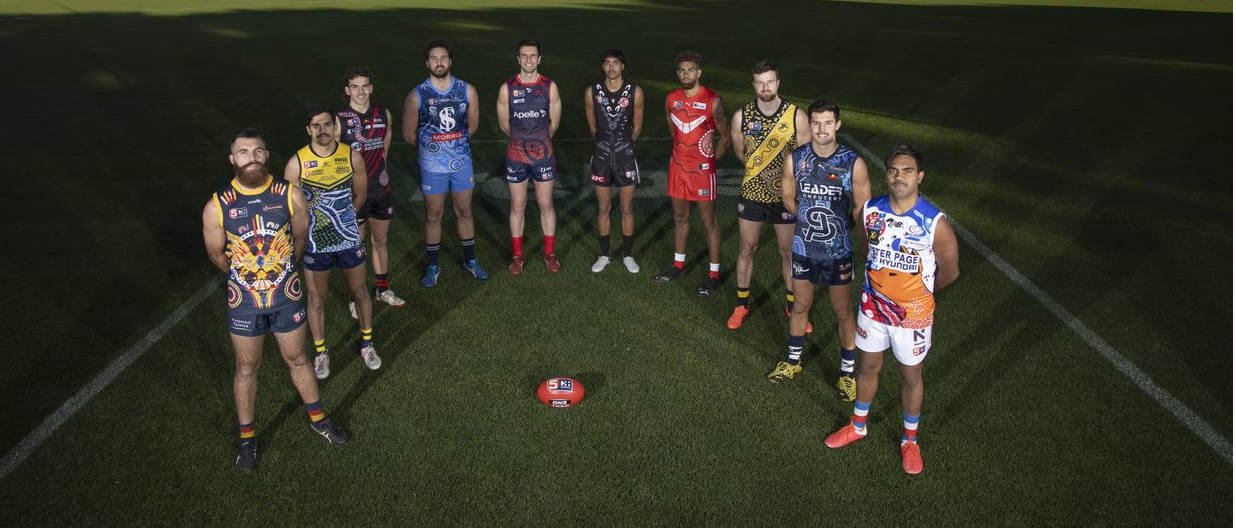
2022 Indigenous Round – Guernsey Designs
As we head into the Hostplus SANFL League’s Indigenous Round and NAIDOC Week 2022, here is every club’s stunning guernsey design and the unique stories behind them.
Indigenous Round is a celebration and recognition of all SANFL Aboriginal and Torres Strait Islander players past and present who have made, and continue to make, such a significant contribution to our national game.
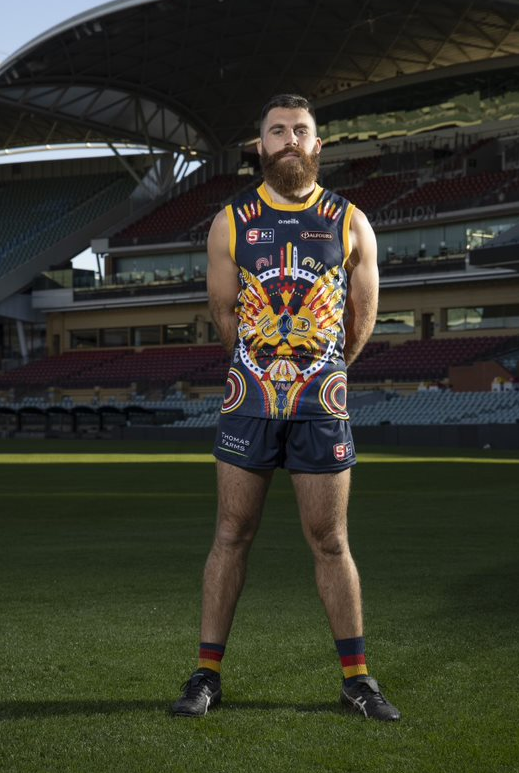
Isaya McKenzie
Designed by Eastern Arrernte man Pat Caruso, this year’s Adelaide Football Club Indigenous guernsey is the first time the same design has been worn across the Club’s AFL, AFLW and SANFL – one guernsey, one Club.
We Fly As One – the design celebrates the whole Club, including the three teams, coming together on our shared reconciliation journey.
The Aboriginal adaptation of the crow sits at the centre of the guernsey, with the Kaurna shield perched proudly on its chest.
The male and female hands which make up the wings of the crow and the fingerprints on the feathers which wrap around the guernsey represent the imprint players, staff, members and supporters have left on the Club over its journey.
Aboriginal male and female symbols sit on its wings, symbolising men’s and women’s players coming together to support, encourage and flourish.
The crow is surrounded by layers of many circles of different sizes, colours, and shapes, symbolic of a meeting place and the Crows community coming together on a shared journey.
A secondary Kaurna shield stands tall at the base of the flight path, surrounded by the footprints of the Crows family whose relentless, consistent, and hardworking attitudes propels the Crows forward.
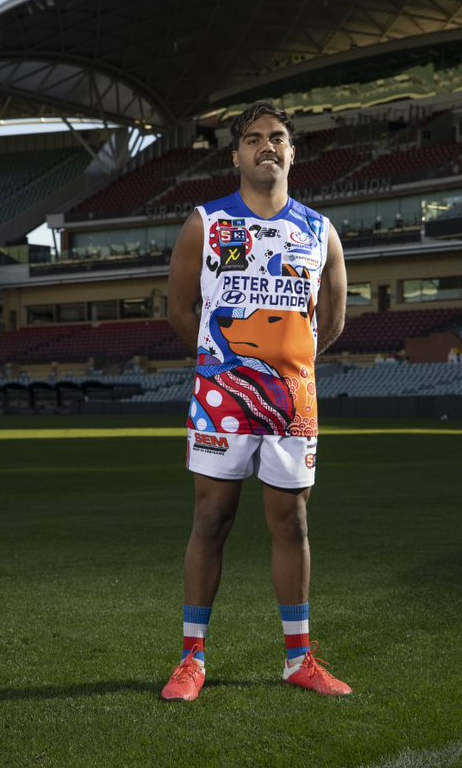
Isaiah Dudley
Central District’s 2022 Indigenous Guernsey was proudly designed by Justin Franey, a year 12 student from a local Aboriginal school, Kaurna Plains School R-12.
Justin explains the meaning of the Central District guernsey design:
It shows Kadli (the dingo). Before Bulldogs there were Kadlirna (dingoes) in this area, now we can be together. Behind the dingo there is the River in Gawler, which is called Kadlitipari (dingo river). This is a meeting place where people would meet, make tools, fish and hunt. They would collect food they need for their families and drink from the river.
At Gawler you can see Scar trees where murlapaka (bark shield) and kuru (coolaman) have been cut. There are the hills next to the dingo which are the hills you can see from Central’s oval.
The small dots around the circles are Purli (stars) and I wanted to show that we all meet under the stars and under the Wirltu Tidna, the eagle’s foot (The Southern Cross).
The large circles are meeting places and show us all meeting together, from different places. We meet together as family telling stories, having yarns, and also playing football. The dingo tracks shows us moving and travel too, to protect each other. This is like my own story, with my travel and my pathways. I was born in Darwin, moved to Alice Springs but Live on Kaurna Country now. The dingo is also my totem.
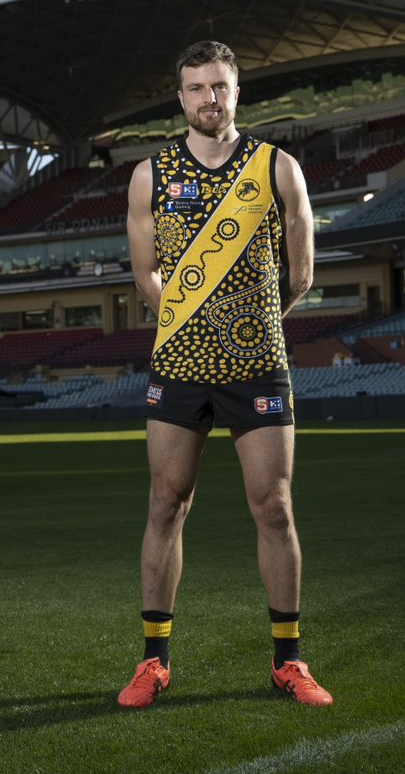
Jordan Murdoch
Anwerne apurte irreme – we are all coming together
Designed by Amanda Turner, the aunty of senior player Gibson Turner, the overall theme of the guernsey is about the Glenelg community and coming together.
The guernsey represents not only the players, but the whole training group, the people within the club and the Bays community – it brings us all together. The circles represent the ground we walk on and everyone coming together as one.
The design also reflects upon the club going through the journey of the football season across the year, as well as our ‘all in’ trademark.
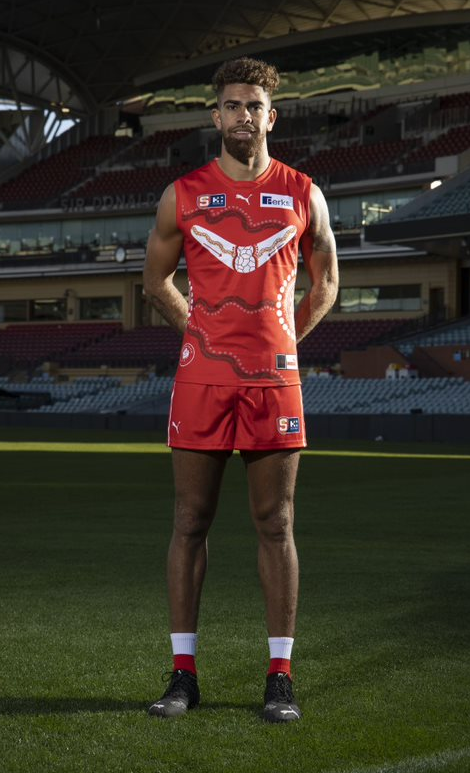
Nigel Lockyer Jnr
North Adelaide’s Indigenous guernsey was designed by Past Players Joel and Matt Campbell.
The two circles represent Alice Springs and Prospect Oval. The path between them represents the path of the players that have come from Alice Springs, as Joel and Matt have done, to play footy for the Roosters.
The guernsey combines their past, present and future connections between Alice and North Adelaide FC and the strong connection we hope to build with the Redtails program which has helped deliver current Roosters star, Nigel Lockyer.
The Goanna on the back of the guernsey represents the dreaming of Matt, Joel and Nigel.
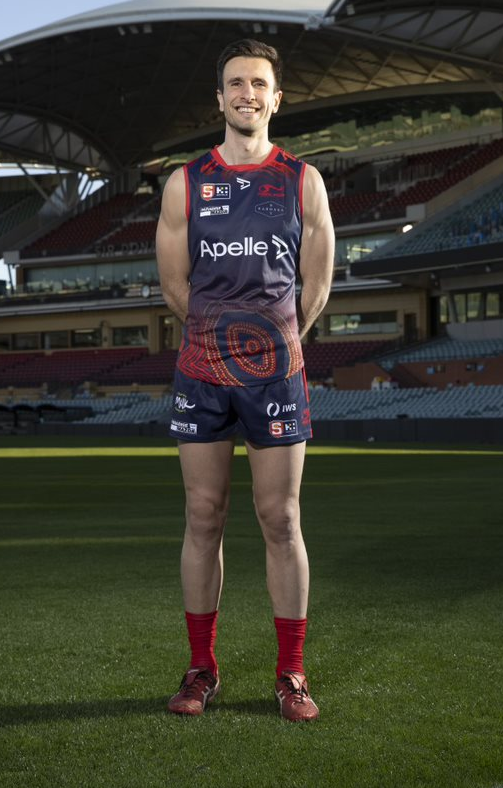
Matt Panos
Norwood’s guernsey was designed by midfielder Dom Barry’s mother, Joanne Ken, a Pitjantjatjara-Yankunytjatjara woman, born in 1968 near Mimili community. It features the Kanpi Rockhole, Kalaya (Emu), ngampu (eggs) for the Kanpi area and Malu (Kangaroo footprints). Joanne Ken is the daughter of Iwana Ken (dec.2014) and Fred Tapatapa (dec.1994).
Iwana (Dom’s Nana) was a Pitjantjatjara woman born in Walytjitjata near the Western Australia, Northern Territory and South Australia tri-state border. Fred was a Yankunytjatjara man whose Country was Mulya Ulpa near Fugon. The guernsey is centred around the events that led to Iwana receiving her new Pitjantjatjatjara name which she popularly became to be known as throughout her life.
Barry said it was an honour for his mother to design the guernsey which he describes as a personal reflection of his mother’s connection to culture.
“The design has turned out amazing,” Barry said. “I am proud of this guernsey for several reasons. One angle is how proud I am of my Mum designing the jumper and the other angle is that we get to showcase the story of my Nana.
“My Mum obviously wanted to be involved in a little bit of her son’s football journey with her having an impact right through my journey…It is one of the proudest moments of my life.”
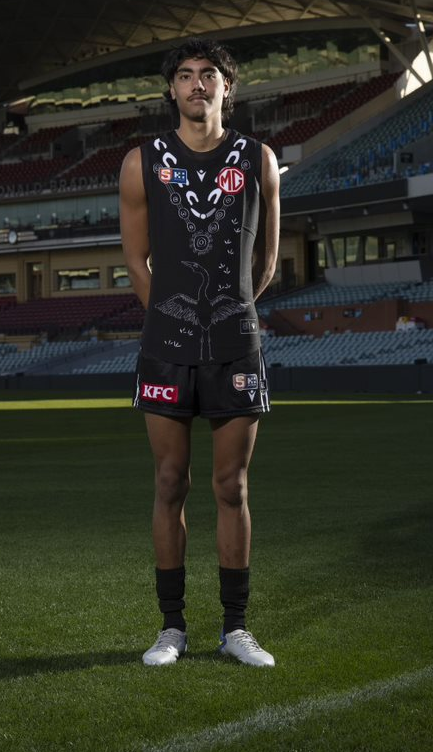
Jase Burgoyne
Designed by Lachie Jones with assistance from his aunty Madeliene Dirdi, Port Adelaide’s SANFL Indigenous Round guernsey (a modified version of the AFL Sir Doug Nicholls Round guernsey) celebrates his journey to discovering more about his Aboriginal heritage and the life and legacy of his grandmother.
The guernsey’s centrepiece is a Brolga – the totem of the Yanyuwa people of Jones’ grandmother’s country at Borroloola, in Arnhem Land, south east of Darwin.
The footprints and the lines and circles around the V on the front of the guernsey represent his Nanna’s journey as a member of the “Stolen Generation” from Borroloola to Bute on the Yorke Peninsula.
On the back, the Brolga in a meeting place represents his Nanna’s final resting place at Bute.
“The art represents me, my family, my grandmother, my people the Yanyuwa people,” Jones said of his design.
“The Brolga is Nanna’s totem. We look after the brolga and the brolga looks after us. As you can see the brolga is taking off and is a powerful creature.
“I have included a boomerang at the bottom of the V as an ancient Aboriginal tool that’s been used for over 60,000 years and is still used in Aboriginal culture today.
“The Brolga on the back of the guernsey is in the centre of the meeting place and this symbolises Nanna’s final resting place and the end of her journey, as well as the beginning of mine.
“Nanna never forgot her family in Borroloola and they have never forgotten us.”
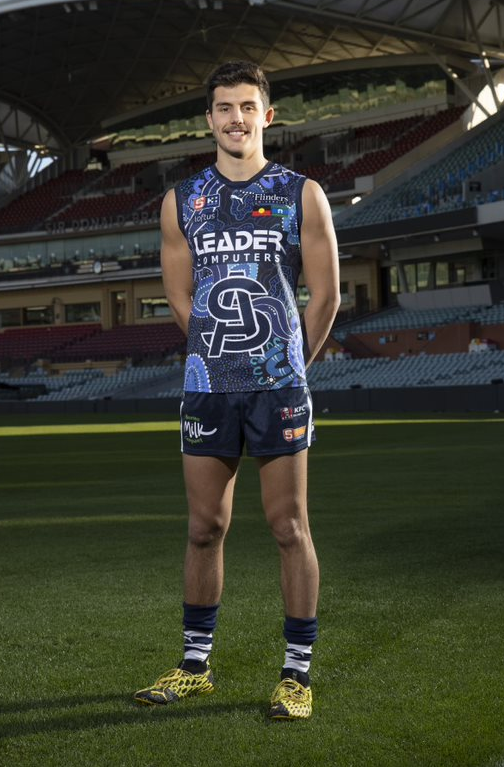
Hayden Sampson
For the first time, both South Adelaide League and Reserves will wear an Indigenous Round jumper to celebrate First Nations People.
Designed by Barkindji woman Caitlyn Davies-Plummer of Dustin-Koa Art, the original painting is called “Ongoing Journey” which not only represents the journey of the football season, but the journey understanding and reconciling with First Nations communities.
Caitlyn said that she feels honoured to have designed the Panthers 2022 Ongoing Journey Guernsey.
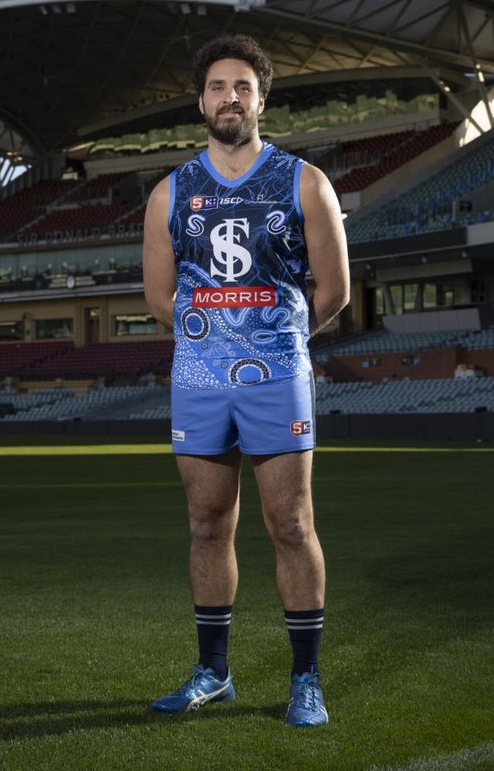
Abe Davis
Sturt’s 2022 Indigenous Round guernsey has been designed by Eastern Arrente Graphic Artist Pat Caruso, in partnership with Aboriginal and Torres Strait Islander players from the club’s senior men’s and women’s playing squads.
The swan is the totem of the Ngarrindjeri people of the River Murray region.
The River Murray is also represented by the songlines on the guernsey, celebrating creation, knowledge and the estuaries of the river.
Kaurna country is represented by the shield, and the coastline of South Australia.
We acknowledge our ancestors through the emu print and people sitting, paying tribute to the dreaming and players of the past. Ancestors are also represented by circles of time, laying subtly throughout our lives and passing on protection and wisdom.
The boomerang is a tribute to past player Jeremy Johncock and all those who take responsibility in being a custodian of culture. It represents protecting and returning to help.
We also acknowledge our Torres Strait Islander players with the symbols of the turtle and stingray. The Hammerhead shark is the family totem of Sturt’s Abe Davis and brother Ben (Adelaide).
Ben Davis has also donated the basket weave pattern, used to make food baskets and representing connection, working together and being united as one Club.
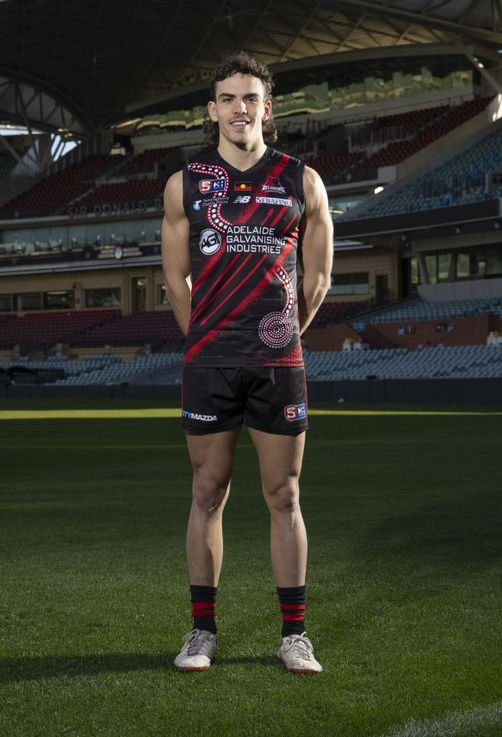
Lachlan Squire
West Adelaide’s Indigenous jumper design is explained by its creators Vivian Davey and Matthew Rankine:
A circle on the front representing Hisense Stadium – our home and place of gathering.
The sash represents the Keswick Creek running alongside the oval and spears inside the sash are the weapons we take to hunt our prey (the opposition). These spears are designed to take down prey that runs, climbs, or flies.
The trail from the circle (Hisense Stadium) is the WAFC players, coaches, support staff and supporters on the game day journey.
Circles on back of guernsey represent the meeting places of our opposition that we’ve infiltrated.
The Kaurna shield on the back is used to protect us during battle to ward off any attacks from our opposition. This is a vital piece of the guernsey as this is a symbolic acknowledgement to the Kaurna people whose land we play on.
The names etched on the guernsey are those of all previous Indigenous footballers to have worn the Red and Black and who have played their part in contributing to getting West Adelaide where it is today.
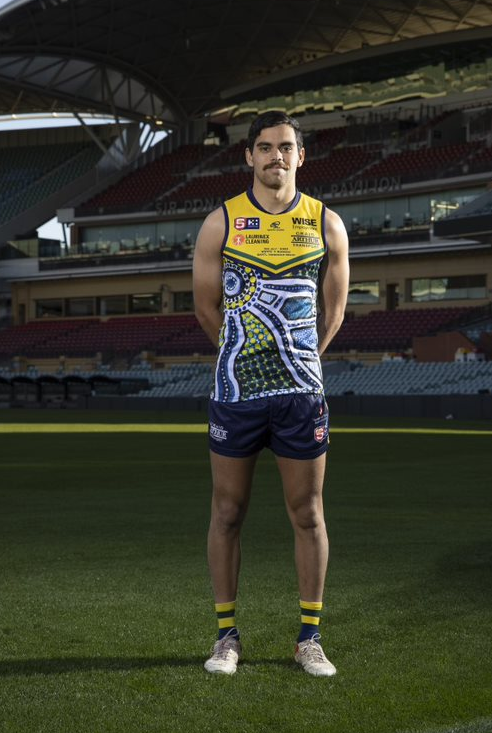
Deakan Jackson
Woodville-West Torrens’ 2022 Indigenous guernsey was designed by Club board member Devinia Binell.
Devinia is a proud Barngarla-Kokatha-Wirangu woman and the club was honoured to have her design move from its polo tops in 2021 to guernseys for this weekend’s game against Norwood.
Devinia explains the design:
“The painting represents my understanding of how important it is to recognise the WWTFC as a true Community Club. The Club has many relationships and partnerships with varying organisations, community groups, and First Nations People. In the artwork, I have tried to capture this and show the many and varying connections.
The large circles represent the WWTFC, with the five smaller circles representing the important connections and valued partnerships with the SANFL Community, Past and Present Players, WWTFC Supporters, Community Football Clubs and most importantly, Aboriginal and Torres Strait Islander Peoples.”
Related News
-
 Milestone
MilestoneJosh Hones in on his 200th Hostplus SANFL League match
-
 Hostplus League
Hostplus LeagueRound 12 Health Partners SANFL Injury Report
Health Partners -
 Snapshot
SnapshotRound 12 Hostplus SANFL Snapshot – Sunday
-
 Snapshot
SnapshotRound 12 Hostplus SANFL Snapshot – Saturday
-
 Match Preview
Match PreviewRound 12 Hostplus SANFL League Match Previews
-
 Hostplus League
Hostplus LeagueWest Adelaide FC Media Release – Adam Hartlett
-
 Team Selections
Team SelectionsRound 12 Hostplus SANFL League Teams
-
 Obituary
ObituaryVale Ian Day








